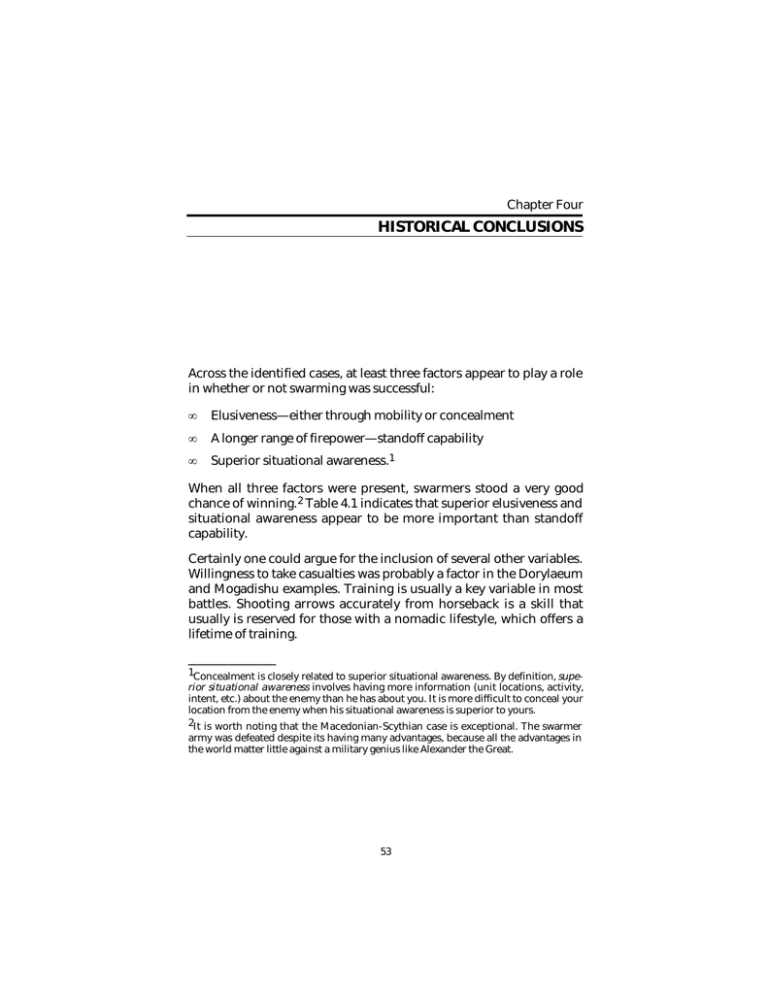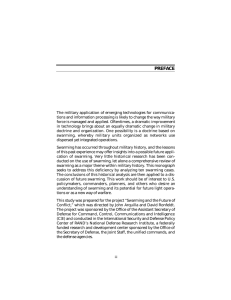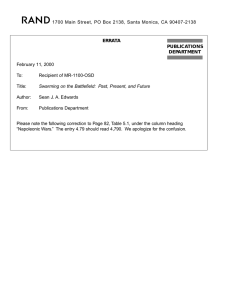HISTORICAL CONCLUSIONS
advertisement

Chapter Four HISTORICAL CONCLUSIONS Across the identified cases, at least three factors appear to play a role in whether or not swarming was successful: • Elusiveness—either through mobility or concealment • A longer range of firepower—standoff capability • Superior situational awareness.1 When all three factors were present, swarmers stood a very good chance of winning. 2 Table 4.1 indicates that superior elusiveness and situational awareness appear to be more important than standoff capability. Certainly one could argue for the inclusion of several other variables. Willingness to take casualties was probably a factor in the Dorylaeum and Mogadishu examples. Training is usually a key variable in most battles. Shooting arrows accurately from horseback is a skill that usually is reserved for those with a nomadic lifestyle, which offers a lifetime of training. ______________ 1Concealment is closely related to superior situational awareness. By definition, superior situational awareness involves having more information (unit locations, activity, intent, etc.) about the enemy than he has about you. It is more difficult to conceal your location from the enemy when his situational awareness is superior to yours. 2It is worth noting that the Macedonian-Scythian case is exceptional. The swarmer army was defeated despite its having many advantages, because all the advantages in the world matter little against a military genius like Alexander the Great. 53 54 Swarming on the Battlefield: Past, Present, and Future Table 4.1 Swarmer Advantages in Ten Specific Battles Superior Situational Awareness Swarmer Strategic Outcome Swarmer vs. Nonswarmer Elusiveness Standoff Capability Scythians vs. Macedonians (Alexandria Eschate) Yes Yes Yes Loss Parthians vs. Romans (Carrhae) Yes Yes Yes Win Seljuk Turks vs. Byzantines (Manzikert) Yes No No Win Turks vs. Crusaders (Dorylaeum) Yes Yes No Loss Mongols vs. Europeans (Liegnitz) Yes Yes Yes Win Napoleonic Corps vs. Austrian army (Ulm) Yes No Yes Win Woodland Indians vs. U.S. Army (St. Clair’s Defeat) Yes No Yes Win Boers vs. British regulars (Majuba Hill) Yes No Yes Win U-boats vs. destroyers (Battle of the Atlantic, 1939–1942) Yes No Yes Win U-boats vs. destroyers/aircraft with radar (Battle of the Atlantic, 1942–1945) No No No Loss Somalis vs. Rangers (Mogadishu) Yes No Yes Win According to this simple pattern-matching, elusiveness and situational awareness appear to be the most important factors in the success of swarming. In Figure 4.1, the intersection of the elusiveness and situational awareness circles is the most crowded region. Standoff capability was important for the horse-archer cases, but less so for the modern infantry cases: The small arms of the Somalis, Boers, and Indians were essentially the same as their opponent’s weapons. Elusiveness allows a swarmer to converge on the enemy in coordination with friendly units when it is advantageous to do so. The historical cases also reinforce the notion that attacks from three or more sides create killing zones, in which both the means and the will to fight are quickly destroyed. Historical Conclusions 55 RAND MR1100-4.1 Elusiveness (mobility or concealment) U-boat (1939–1942) Seljuk Turks Turks Woodland Indians Napoleonic Corps Somalis Mongols Boers Scythians Parthians Standoff firepower Situational awareness Figure 4.1—What Advantages Do Swarmers Need? Some limitations to swarming tactics are apparent. Swarmers were sometimes incapable of a quick knockout blow. The capability for shock action appears to enhance swarmer effectiveness. Most swarmer armies had to wear down their opponents through attrition and standoff fire. The Mongol tactical example is one of the exceptions: Although they usually liked to soften up the target first, their heavy cavalry was capable of delivering the coup de grâce. Terrain appears to have constrained swarming tactics. Swarmers that relied on cavalry for their mobility required terrain with maneuver space (roads, grazing lands, desert, and open plains). Swarmers that relied on concealment for their elusiveness, such as light infantry and U-boats, required concealing terrain such as oceans, forests, and cities. The historical record of swarming attacks on fixed defenses is a mixed one, so its implications for doctrine are still in question. Using 56 Swarming on the Battlefield: Past, Present, and Future minefields and other obstructions, a well-prepared defense in a fixed position might very well be able to channel an attack and prevent a swarming maneuver.3 Swarmers successfully attacked a fixed defense when they could remain elusive (Boers), but failed when they could not (Scythians against Alexander’s walled strongpoints). Even the Mongols had trouble storming the fortified castles of Eastern Europe, such as after the victory of Liegnitz, when they failed to take Breslau or the castle of Liegnitz. Defensive swarming must necessarily be porous to some degree, to allow the enemy to penetrate home territory so that local units can swarm toward the invader (for example, Boers, Somalis, and insurgents in general). The cases have highlighted some successful countermeasures to swarm tactics, such as • pinning a swarm force using either a part of one’s own force or a geographic obstacle (Alexander, Crusaders) • eliminating the swarm force’s standoff-fire advantage (Byzantines) • eliminating the swarm force’s mobility or elusiveness advantage (U-boats) • securing the countryside by building a linked network of fortifications (Macedonians) • separating the swarmer from his logistics base (Macedonians). The effect of swarming on morale is an interesting factor to consider across the observed cases, but it is hard to measure. When a swarming army attacks a defender from all sides, it appears to have an unnerving psychological effect. It is well established that morale wavers when soldiers come under attack from the flanks and/or rear in addition to the front.4 Soldiers like to know that they have an ______________ 3Probably the most difficult type of swarm maneuver is an attack on a prepared defense in an urban area. 4One could foresee a situation in which a swarm attack that completely surrounds an army causes the defenders to fight with even more desperation. If a “hole” is left in the Historical Conclusions 57 escape route and that their lines of supply remain open. Because fear is contagious, most battles are won or lost in the minds of the participants, long before the losing side is physically destroyed. Almost all armies have a breaking point in terms of casualties incurred. Coming under a swarm attack appears to lower that breaking point.5 In general, command, control, and communications have been primitive in pre–twentieth century swarming cases. Without wireless communication, it is difficult to coordinate many units without keeping them within sight of each other. Interestingly, in all these cases except one—Mogadishu—the swarmer unit was semiautonomous. See Table 4.2. Elusiveness was usually based on mobility—the use of horses; in more-modern cases, light infantry used concealment to remain elusive. Rarely did elusiveness stem from both mobility and concealment: Sometimes light infantry were more mobile, sometimes not. Insurgents and Indians were more mobile because they carried less gear and knew the terrain. However, the Somalis were not more mobile. In the U-boat case, concealment was gained at the price of mobility. There is no land example of vehicle-based swarming. Table 4.3 summarizes observations on elusiveness. Logistics has always been a big challenge for swarmers (as well as for conventional armies). Even when insurgent swarmers relied on the indigenous population and the countryside, they rarely fielded major forces for any sustained campaigning. For the operational-level swarmers such as the Mongols and La Grande Armée, a logistics breakthrough was necessary. The Mongol horsemen used immense herds of replacement horses; they were limited to some extent by the availability of good grazing land for their herds. As well, the Mongol soldiers themselves were incredibly hardy individuals. They were circle of attackers, it encourages men with low morale to flee for their lives. The Mongols liked to leave a hole, which usually was set up along an ambush route. 5Napoleon once said that “the morale is to the physical as three to one.” Morale has always been important in war; however, in this study, it was difficult to look for patterns in morale because of the paucity of historical records. 58 Swarming on the Battlefield: Past, Present, and Future Table 4.2 Swarmer Command and Control in the Past Swarmer vs. Nonswarmer Degree of Autonomy Between Swarmer Units Scythians vs. Macedonians Semiautonomous Little Tacit Voice, signals, and standards Parthians vs. Romans Semiautonomous Little Tacit Voice, signals, and standards Seljuk Turks vs. Byzantines Semiautonomous Little Tacit Voice, signals, and standards Turks vs. Crusaders Semiautonomous Little Tacit Voice, signals, and standards Mongols vs. Eastern Europeans Semiautonomous Moderate Explicit Voice, signals, and standards; courier pigeon; human run-ners; smoke Woodland Indians vs. U.S. Army Semiautonomous Moderate Explicit Cavalry runners Napoleonic Corps vs. Austrians Semiautonomous Little Tacit Voice, signals, human runners Boers vs. British Semiautonomous Little Tacit Voice, human runners U-boats vs. British destroyers Semiautonomous None Explicit Somalis vs. U.S. Commandos Autonomous Little Explicit and tacit Amount of Communication Between Swarmer Units Nature of Communication Between Swarmer Units Communication Technology Radio Voice, cell phone Historical Conclusions 59 Table 4.3 The Nature of Elusiveness Swarmer vs. Nonswarmer Nature of Elusiveness Why? Scythians vs. Macedonians Mobility Horses Parthians vs. Romans Mobility Horses Seljuk Turks vs. Byzantines Mobility Less armor Turks vs. Crusaders Mobility Less armor Mongols vs. Eastern Europeans Mobility Horses, multiple mounts per man Woodland Indians vs. U.S. Army Mobility Dispersed formations foraged off the land, carried fewer supplies Napoleonic Corps vs. Austrians Concealment Nature of wooded terrain, indigenous support Boers vs. British Mobility and concealment Horses, nature of terrain, indigenous support U-boats vs. British Convoys Concealment Submersible U-boat, Schnorchel, countermeasures against ASDIC (burrowing in the mud in shallow water) Somalis vs. U.S. Commandos Concealment The use of noncombatants, nature of urban terrain known to cut the artery in their horses’ neck and drink the blood while on the march. Napoleon’s corps foraged off the land, taking what they needed from the countryside.6 See Table 4.4. ______________ 6The last army to experience a revolutionary leap in logistics capability was La Grande Armée of Napoleon’s day. Superior logistics was one of the secrets behind Napoleon’s ability to outmaneuver his adversaries and rapidly concentrate his corps d’armée system. His ground forces enjoyed shorter logistical tails because they lived off the land during the march, rather than transporting all their supplies with them on the campaign. Because of the levee en masse and internalized discipline, French soldiers could be trusted to disperse and forage for supplies without taking the opportunity to desert their comrades. The greater dispersion and speed of Napoleon’s corps allowed him to conduct war at the operational level. 60 Swarming on the Battlefield: Past, Present, and Future Table 4.4 Logistics Problems and Solutions for Swarmers in the Past Swarmer vs. Nonswarmer Logistics Requirements Scythians vs. Macedonians Food and fodder, firewood Operate in grazing terrain Parthians vs. Romans Food and fodder, firewood Operate in grazing terrain Seljuk Turks vs. Byzantines Food and fodder, firewood Operate in grazing terrain Turks vs. Crusaders Food and fodder, firewood Operate in grazing terrain Mongols vs. Eastern Europeans Food and fodder, firewood Operate in grazing terrain Woodland Indians vs. U.S. Army Food Have indigenous support; Napoleonic Corps vs. Austrians Food and fodder, firewood, gunpowder, ammunition Forage off the land in dispersed formations Boers vs. British Food and fodder, firewood, gunpowder, ammunition Have indigenous support U-boats vs. destroyers Food, fuel, ammunition Use surface resupply ships Somalis vs. U.S. Commandos Food, ammunition Have indigenous support; keep campaign short Logistics Solution keep campaign short In pre-industrial cases, the logistics requirements were minuscule compared with the needs of a modern mechanized force. Before war became mechanized, food, fodder for the horses, and firewood for cooking were the critical supplies required for an army to march and fight. Mechanized armies with crew-served weapons demand ammunition and parts several orders of magnitude greater than those of the armies that were fielded before WWI.7 ______________ 7The increasing mechanization of war since WWI has led to an exponential growth in the logistics demands of combat units. While crew-served weapons now expend vast quantities of ammunition, armored vehicles place greater and greater fuel demands on modern supply systems. Even during WWII, most successful armored break- Historical Conclusions 61 History can be used to identify the problems that swarmers encountered in the past. It can also highlight by omission new problems for present and future forces. For example, swarmers have never encountered minefields. If swarming is used in the future, will extensive mining prevent swarmers from dispersing and converging? Table 4.5 highlights these problems. Table 4.5 Are Historical Constraints on Swarming Still a Problem? Problem Explanation Present Solution Available? No knockout blow Lightly armed swarmer units had to wear down the nonswarmer army through the standoff fire of the bow, an attrition strategy without a knockout blow. Swarmer effectiveness is greatly enhanced when it is also capable of shock action. The Mongols had heavy cavalry to deliver coup de grâce after softening up the target. Indirect fires may provide a knockout blow if the enemy is concentrated and located by sensors. Airpower (such as AC-130 gunships), MLRS ATACMS, field artillery, offshore Naval fire support, and space weapons can be used to provide indirect fire support. Restrictive terrain Noninfantry swarmers need maneuver space (roads, grazing lands, desert and open plains, the ocean, and the air). There are no cases of mounted swarmers operating in difficult terrain. Light strike vehicles are capable of operating in most terrain. Dismounted swarmer teams are possible. Logistics Pre-mechanized age had relatively small logistics burden. Even so, either the swarmer had to be on the defense or a minor logistics RMA was needed. A package of fixes: GPS delivery, air superiority, informationmanagement improvements, etc. Minefields Nonexistent before WWI. Coastal sea mines used against U-boats. Could be a problem. Support political ban? Fratricide, disregard for high friendly casualties Sometimes swarmers suffered very little (Boers), sometimes a lot (Somalis). Improved situational awareness, precision engagement. Use direct-fire weapons that will not harm friendly forces on the opposite side of the target. Use nonlethal weapons. throughs by either side on the Eastern Front were invariably brought to a halt by the lack of logistics support. Today, the 68-ton U.S. main battle tank requires refueling every 8 hours and can expend its limited basic load of ammunition in minutes of heavy contact. 62 Swarming on the Battlefield: Past, Present, and Future A modern swarming doctrine demands superiority in many technological areas. Therefore, its ultimate feasibility will depend on the benefits emerging from the revolution in communications and computers. Many benefits are already being realized. Several underway governmental research and development efforts may be relevant to a discussion of swarming, including the Army’s Army XXI and AAN work and the Marine Corps’ Urban Warrior program. The U.S. Army is already proceeding with its FORCE XXI modernization effort to eventually create “Army XXI.” 8 Army XXI units will be “digitized,” communicating via a tactical internet and relying on a network of communication systems to improve situational awareness. Concentration of fire will be more important than concentration of mass on the battlefield. Army XXI operations will be more dispersed and nonlinear than in the past. Planning also is under way for a modernized force called the Army After Next (AAN), which will rely on weapons and technologies available after 2010. Preliminary studies by Training and Doctrine Command (TRADOC) on the likely characteristics of an AAN force have tentatively concluded that greater dispersion of units, lighter-weight vehicles, “air-mechanized” forces, and a more network-based organization are desirable. The current vision is of light battle forces that can be air-mobiled across the theater using advanced airframes. Units will maneuver in dispersed operations and rely in part on “reachback” indirect weapons.9 The light battle force essentially uses a concept similar to swarming in that it waits for an enemy to penetrate its defensive area, relies upon stealth to elude the enemy, and unleashes an ambush of massive simultaneous fires from close in and afar.10 ______________ 8FORCE XXI is the Army’s modernization process to field an Army for the twenty-first century. The Army is upgrading many of its major weapon systems, but current modernization involves few new weapon systems. The central effort is the digitization of the force—the application of information and communication technologies (drawn for the most part from the commercial sector) to share real-time information with every dismounted soldier, vehicle, aircraft, weapon, and sensor on the battlefield. 9 “Reachback” indirect weapons are very long-range weapons deep in the rear. 10See unpublished RAND research by J. Matsumura, R. Steeb, T. Herbert, S. Eisenhard, J. Gordon, M. Lees, and G. Halverson, “The Army After Next: Exploring New Concepts and Technologies for the Light Battle Force.” Historical Conclusions 63 The Marine Corps is exploring an “Urban Swarm” operational concept as part of its urban-warfare experimentation. 11 The Marines like to say that the urban swarm is similar to police tactics in emergency situations. Marine swarming calls for multiple squad-sized fire teams patrolling assigned areas, responding to crises, and calling for backup from other fire teams when necessary.12 The Marine Corps After Next (MCAN) branch of the Marine Corps Warfighting Lab is also taking a look at a future force that will be dispersed, autonomous, adaptable, and small. It is probable that technological advances associated with these efforts will alleviate some of the historical problems with swarming identified in this monograph. In the next chapter, this critical assumption—that future developments will make modern swarming feasible for U.S. light or medium forces—will be explored further with a discussion of swarm tactics, logistics, command, organization, and technology. ______________ 11The Marines conducted limited experiments on the East Coast as part of their Urban Warrior program, to learn and apply new tactics for military operations on urbanized terrain (MOUT). The entire effort culminated in a final Advanced Warfighting Experiment on the West Coast in spring 1999. 12George Seffers, “Marines Develop Concepts for Urban Battle Techniques,” Defense News, January 12–18, 1998.


